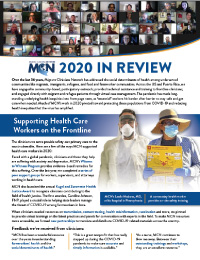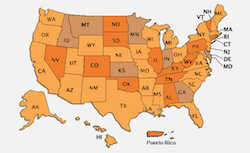- Who We Are
- Clinician Employment
- Publications
- Witness to Witness (W2W)
- Kugel & Zuroweste Health Justice Award
- Your Voice Matters: Photovoice Project
Indecent Exposure: Lead Puts Workers and Families at Risk
Describes the adverse health effects of lead in workers with blood-lead levels of 5-10 ug/dL and recommend changing OSHA’s medical removal trigger of 60 ug/dL.
Files
-
- Perspectives Lead Exposure ( 1 Mb )
Journal of Agromedicine
Occupational Health Outcomes for Workers in the Agriculture, Forestry and Fishing Sector: Implications for Immigrant Workers in the Southeastern US
Sara A. Quandt, PhD, Kristen L. Kucera, PhD, Courtney Haynes, MS, Bradley G. Klein, PhD, Ricky Langley, MD, Michael Agnew, PhD, Jeffrey L. Levin, MD, Timothy Howard, PhD, and Maury A. Nussbaum, PhD
Background Workers in the Agriculture, Forestry, and Fisheries (AgFF) sector experience exposures directly related to the work itself, as well as the physical environment in which the work occurs. Health outcomes vary from immediate to delayed, and from acute to chronic.
Files
-
- Quandt et al Occupational health outcomes ( 188 Kb )
Occupational Health Policy and Immigrant Workers in the Agriculture, Forestry, and Fishing Sector
By Amy K. Liebman, MPA, MA, Melinda F. Wiggins, MTS, Clermont Fraser, JD, Jeffrey Levin, MD, MSPH, Jill Sidebottom, PhD, and Thomas A. Arcury, PhD
Background Immigrant workers make up an important portion of the hired workforce inthe Agricultural, Forestry and Fishing (AgFF) sector, one of the most hazardous industrysectors in the US. Despite the inherent dangers associated with this sector, workerprotection is limited.
Files
-
- Liebman et al Occupational Health Policy ( 126 Kb )
Pesticide Exposure in Children - Policy Statement
Children encounter pesticides daily and have unique susceptibilities to their potential toxicity. Acute poisoning risks are clear, and understanding of chronic health implications from both acute and chronic exposure are emerging. Epidemiologic evidence demonstrates associations between early life exposure to pesticides and pediatric cancers, decreased cognitive function, and behavioral problems.
Files
-
- PestExposureChild Policy AAP ( 536 Kb )
Pesticide- related illness among migrant Farm Workers in the United States
Surveillance data show that pesticide-related illness is an important cause of acute morbidity among migrant farm workers in California. Exposures occur in various ways (e.g., residues, drift), suggesting that the use of pesticides creates a hazardous work environment for all farm workers Improved education for health care providers should be a priority.
PNASH Center Research Projects
Research projects and studies conducted by the Pacific Northwest Agricultural Health and Safety Center at the University of Washington.
Promoting Integrated Approaches to Reducing Health Inequities Among Low-Income Workers: Applying a Social Ecological Framework
Sherry L. Baron, MD, MPH, Sharon Beard, MS, Letitia K. Davis, ScD, EdM, Linda Delp, PhD, MPH, Linda Forst, MD, MPH, Andrea Kidd-Taylor, PHD, Amy K. Liebman, MPA, MA, Laura Linnan, ScD, Laura Punnett, ScD, and Laura S. Welch, MD
Repeated Pesticide Exposure among North Carolina Migrant and Seasonal Farmworkers
Limited data document the multiple and repeated pesticide absorption experienced by farmworkers in an agricultural season or their risk factors.
Surveillance for Pesticide- Related Disease
Public health surveillance for acute pesticide intoxications is discussed. Explanation of the goals, components and functions of population-based surveillance is provided with reference to key informational sources.




